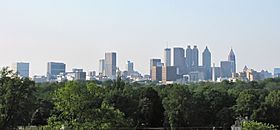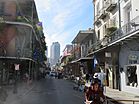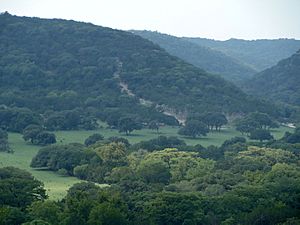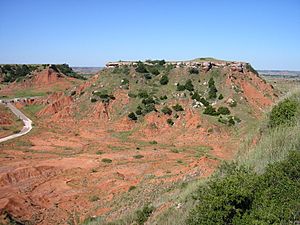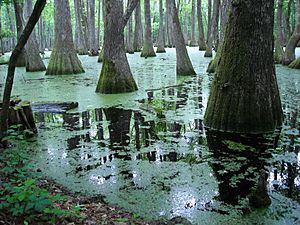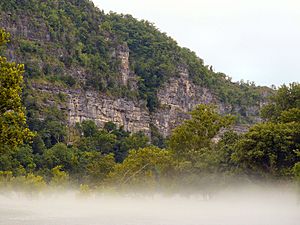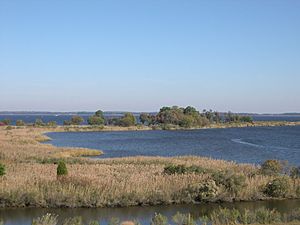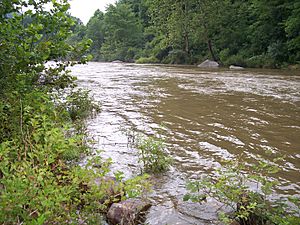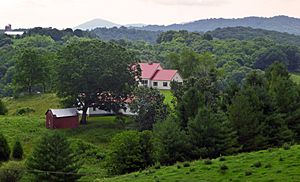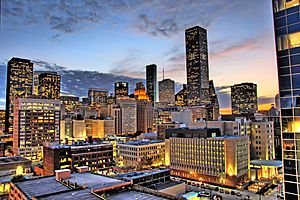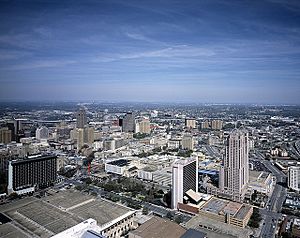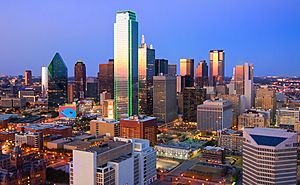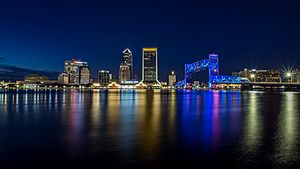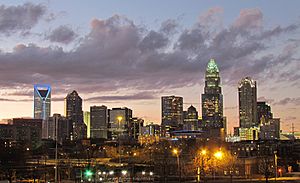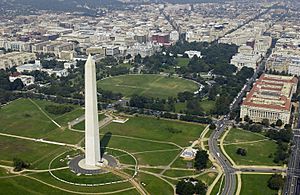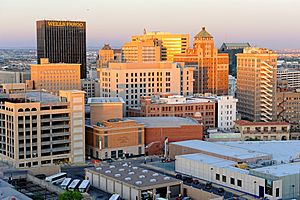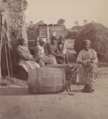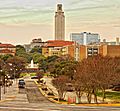Southern United States facts for kids
Quick facts for kids
Southern United States
The South (South east)
|
|
|---|---|
|
Cultural region of the United States
|
|
|
Left - right from top: Downtown Houston skyline, Ryman Auditorium, Cathedral Basilica of St. Augustine, Atlanta, Georgia, French Quarter of New Orleans, Bridge over the Mississippi River
|
|
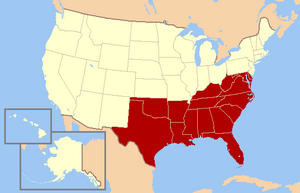
The Southern United States as defined by the United States Census Bureau.
|
|
| Subregion |
|
| Country | |
| States | |
| Population
(2018 United States Census Estimates)
|
|
| • Total | 124,753,948 |
| Demonym(s) | Southerner |
The Southern United States, also called the American South or just the South, is a large region in the USA. It is located between the Atlantic Ocean and the Western United States. To its north are the Midwestern United States and Northeastern United States. The Gulf of Mexico and Mexico are to its south.
The South does not exactly match the geographic south of the country. It usually includes the states that fought for the Confederate States of America in the American Civil War. The Deep South is found in the southeastern part of the region. States like California, Arizona, and New Mexico are in the geographic south but are not considered part of the South. However, West Virginia, which separated from Virginia in 1863, is often included.
States like Delaware, Maryland, and Washington, D.C. allowed slavery before the Civil War. But they stayed with the Union during the war. After the Civil Rights Movement in the 1960s, these areas became more like the industrial Northern states. Many people now see them as part of the Mid-Atlantic or Northeast. However, the United States Census Bureau still counts them as part of the South for official purposes.
The South is known for its unique culture and history. It has its own customs, music, and foods. These things make it different from other parts of the United States. The people in the South come from many different backgrounds. These include people of European (like English, Italian, Scottish, Scotch-Irish, Irish, German, French, Portuguese, and Spanish) heritage. There are also many African and some Native American people.

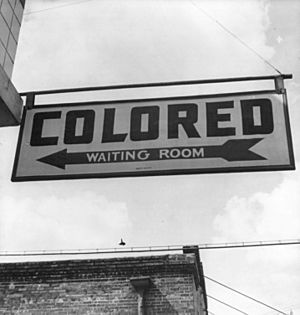
Historically, the South had slave labor on large farms called plantations. This was especially true in the Deep South. This led to a large number of African Americans living in the region. After the Civil War and the Reconstruction Era, there were many challenges. Laws called "Jim Crow laws" created a segregated system. This meant separate schools and public places for black and white people. Also, methods like poll taxes often stopped black people from voting. These practices lasted until the 1960s.
Since the Civil Rights Act of 1964, black people have held many important positions in Southern states. This is especially true in states like Virginia and South Carolina. Black leaders have become mayors and police chiefs in major cities. These include Baltimore, Charlotte, Raleigh, Birmingham, Richmond, Columbia, Memphis, Houston, Atlanta, Jacksonville, Jackson, and New Orleans. They also serve in the U.S. Congress and state governments.
In the past, the South relied heavily on agriculture. It was mostly rural until after 1945. Since then, it has grown more industrial and urban. Many people from other parts of the U.S. and other countries have moved there. The American South is now one of the fastest-growing areas in the United States. Houston is the largest city in the Southern United States. People who study society say that the South's unique identity comes from its distinct politics, population, and culture.
The region includes almost all of the Bible Belt. This is an area where many people attend Protestant churches, especially evangelical ones like the Southern Baptist Convention. Politics in this area are often conservative and influenced by religion. Studies show that Southerners are more conservative than people from other regions in areas like religion, morality, and how they view other countries. This can be seen in how often people go to church and how strongly the region supports the Republican Party in elections, especially since the 1990s. Even with its unique climate, life in the South is becoming more similar to the rest of the nation.
Contents
Geography of the South
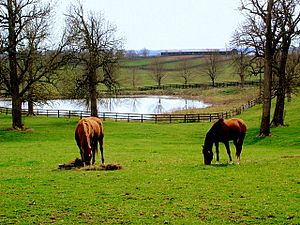
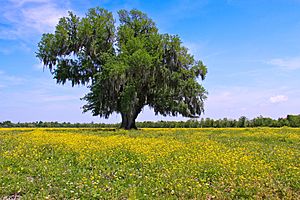
The United States Census Bureau defines the Southern region of the United States as including sixteen states. In 2010, about 114.5 million people lived in the South. This was about 37% of all U.S. residents, making it the most populated region. The Census Bureau divides the South into three smaller areas:
- The South Atlantic States: Delaware, Florida, Georgia, Maryland, North Carolina, South Carolina, Virginia, and West Virginia.
- The East South Central States: Alabama, Kentucky, Mississippi, and Tennessee.
- The West South Central States: Arkansas, Louisiana, Oklahoma, and Texas.
The Council of State Governments is an organization that helps states communicate. Their South regional office includes Alabama, Arkansas, Florida, Georgia, Kentucky, Louisiana, Mississippi, Missouri, North Carolina, Oklahoma, South Carolina, Tennessee, Texas, Virginia, and West Virginia.
Other names for parts of the South include:
- The Old South: This can mean the slave states that existed in 1776 (Virginia, Delaware, Maryland, Georgia, North Carolina, and South Carolina). It can also mean all slave states before 1860, which included newer states like Kentucky, Tennessee, Alabama, Florida, Mississippi, Missouri, Arkansas, Louisiana, and Texas.
- The New South: This usually refers to the South Atlantic States.
- Dixie: This term has different meanings. Most often, it refers to the 11 states of the Old Confederacy.
- Southeastern United States: This usually includes the Carolinas, the Virginias, Tennessee, Kentucky, Georgia, Alabama, Mississippi, and Florida.
- The Solid South: This was a region mostly controlled by the Democratic Party from 1877 to 1964. This was especially true after many black people lost their right to vote around 1900. It includes at least all 11 former Confederate States.
- Southern Appalachia: This mainly refers to areas in the Southern Appalachian Mountains. These include Eastern Kentucky, East Tennessee, Western North Carolina, Western Maryland, West Virginia, Southwest Virginia, North Georgia, and Northwestern South Carolina.
- Upland South: This includes Kentucky, Virginia, West Virginia, Tennessee, North Carolina, and sometimes Missouri, Maryland, and Delaware.
- Border South: These states were on the edge of the Confederacy but did not leave the United States in the 1860s. They were Missouri, Kentucky, Maryland, and Delaware. Many people from these states joined the Confederate army. West Virginia formed in 1863 when the western part of Virginia broke away. This was because they did not want to join the Confederacy.
- Tidewater: These are the low-lying Atlantic coastal plain regions of Maryland, Delaware, Virginia, and North Carolina.
- The Gulf South: This term has various definitions. It usually includes the Gulf coasts of Florida, Louisiana, Mississippi, Texas, and Alabama.
- The Deep South: This term also has different meanings. It usually includes Louisiana, Alabama, Mississippi, Georgia, and South Carolina. Parts of nearby states like North and East Texas, Arkansas, Tennessee, and northern and central Florida are also sometimes included.
- The Mid-South: This can refer to the East and West South Central United States, as defined by the Census Bureau. Informally, it often means Tennessee, Arkansas, Mississippi, and sometimes nearby areas.
The popular idea of "the South" is more informal. It is usually linked to the 11 states that left the Union before or during the Civil War. These states formed the Confederate States of America. In the order they left, they were: South Carolina, Mississippi, Florida, Alabama, Georgia, Louisiana, Texas, Virginia, Arkansas, Tennessee, and North Carolina. These states share a common history and culture that continues today. Oklahoma was not a state during the Civil War. However, its main Native American tribes signed treaties to support the Confederacy.
The South has many different weather zones. These include temperate, sub-tropical, tropical, and arid areas. However, the South is generally known for being hot and humid. It has long summers and short, mild winters. Most of the South is in the humid subtropical climate zone. This is except for higher elevations and areas near the western, southern, and some northern edges. Crops grow easily in the South. Its climate always provides at least six months for growing before the first frost. Another common environment is found in the bayous and swamplands of the Gulf Coast. This is especially true in Louisiana and Texas.
The states usually considered part of "The South" are:
- Virginia
- Tennessee
- Arkansas
- Louisiana
- North Carolina
- South Carolina
- Mississippi
- Alabama
- Georgia
- Florida
- Texas
States sometimes called Southern, known as Border States, are:
The cuisine of the Southern United States is very different from other regions.
Major Cities in the South
The South was mostly rural until the 1940s. Now, more and more people live in large city areas. The tables below show the twenty largest cities and metropolitan areas in the South. Houston is the biggest city in the Southern United States.
| Rank | City | State | Population (2018 est.) |
|---|---|---|---|
| 1 | Houston | TX | 2,325,502 |
| 2 | San Antonio | TX | 1,532,233 |
| 3 | Dallas | TX | 1,345,047 |
| 4 | Austin | TX | 964,254 |
| 5 | Jacksonville | FL | 903,889 |
| 6 | Fort Worth | TX | 895,008 |
| 7 | Charlotte | NC | 872,498 |
| 8 | Washington | DC | 702,455 |
| 9 | El Paso | TX | 682,669 |
| 10 | Nashville | TN | 669,053 |
| 11 | Memphis | TN | 650,618 |
| 12 | Oklahoma City | OK | 649,021 |
| 13 | Louisville | KY | 620,118 |
| 14 | Baltimore | MD | 602,495 |
| 15 | Atlanta | GA | 498,044 |
| 16 | Miami | FL | 470,914 |
| 17 | Raleigh | NC | 469,298 |
| 18 | Virginia Beach | VA | 450,189 |
| 19 | Tulsa | OK | 400,669 |
| 20 | Arlington | TX | 398,112 |
Major Metropolitan Areas
| Rank | Metropolitan Statistical Area | State(s) | Population (2018 est.) |
|---|---|---|---|
| 1 | Dallas-Fort Worth-Arlington | TX | 7,539,711 |
| 2 | Houston-The Woodlands-Sugar Land | TX | 6,997,384 |
| 3 | Washington-Arlington-Alexandria | VA-MD-WV-DC | 6,249,950 |
| 4 | Miami-Fort Lauderdale-West Palm Beach | FL | 6,198,782 |
| 5 | Atlanta-Sandy Springs-Roswell | GA | 5,949,951 |
| 6 | Tampa-St. Petersburg-Clearwater | FL | 3,142,663 |
| 7 | Baltimore-Columbia-Towson | MD | 2,802,789 |
| 8 | Orlando-Kissimmee-Sanford | FL | 2,572,692 |
| 9 | Charlotte-Concord-Gastonia | NC-SC | 2,569,213 |
| 10 | San Antonio-New Braunfels | TX | 2,518,036 |
| 11 | Cincinnati-Northern Kentucky| OH-IN-KY | 2,190,209 | |
| 12 | Austin-Round Rock-San Marcos | TX | 2,168,316 |
| 13 | Nashville-Davidson-Murfreesboro-Franklin | TN | 1,930,961 |
| 14 | Virginia Beach-Norfolk-Newport News | VA-NC | 1,728,733 |
| 15 | Jacksonville | FL | 1,534,701 |
| 16 | Oklahoma City-Norman | OK | 1,396,445 |
| 17 | Raleigh-Cary | NC | 1,362,540 |
| 18 | Memphis-Forrest City | TN-MS-AR | 1,350,620 |
| 19 | Richmond-Petersburg | VA | 1,306,172 |
| 20 | Louisville-Jefferson County| KY-IN | 1,297,310 |
* Asterisk indicates part of the metropolitan area is outside the states classified as Southern.
People and Heritage
The South is the most diverse region in the United States when it comes to different racial groups. The main culture of the original Southern states came from England.
In the 1600s, most people who chose to move to the South were from England. They mainly settled along the eastern coast. By the 1700s, they had moved as far inland as the Appalachian Mountains. Most early English settlers were indentured servants. This meant they worked for a period to pay for their trip to America. Wealthier men who paid their own way received land grants. These were called headrights, and they encouraged more people to settle.
The Spanish and French also started settlements in Florida, Texas, and Louisiana. The Spanish settled Florida in the 1500s. Their population was largest in the late 1600s. However, there were not many people because the Spanish were not very interested in farming. Florida also did not have many valuable minerals.
In the British colonies, people started arriving in 1607. This continued until the American Revolution began in 1775.
In the mid-to-late 1700s, large groups of Ulster Scots (later called the Scotch-Irish) and people from the Anglo-Scottish border region moved to America. They settled in the backcountry of Appalachia and the Piedmont. They were the largest group of non-English immigrants from the British Isles before the American Revolution.
In the 1980 Census, 34% of Southerners said they had English ancestors. English was the most common European ancestry reported in every Southern state by a large amount.
Images for kids
-
1st Maryland Regiment holding the line at the Battle of Guilford Courthouse in North Carolina, 1781
-
The siege of Yorktown prompted Great Britain's surrender in North America during the American Revolutionary War, 1781
-
Slaves on a South Carolina plantation (The Old Plantation, circa 1790)
-
Horse race meeting at Jacksonville, Alabama, 1841
-
Atlanta's railroad roundhouse in ruins shortly after the end of the Civil War
-
An African American family, photo-graphed by O'Pierre Havens, circa 1868
-
A Home on the Mississippi, by Currier and Ives, 1871
-
Naval Air Station Miami, circa 1942–43
-
Street musicians in Maynardville, Tennessee, photographed in 1935
-
Alabama plays Texas in American football for the 2010 BCS National Championship Game
-
Houston vs Texas face-off during the 2013 Lone Star Series in the American League West division of Major League Baseball
-
The start of the 2015 Daytona 500, the biggest race in NASCAR, at Daytona International Speedway in Daytona Beach, Florida
See also
 In Spanish: Sur de Estados Unidos para niños
In Spanish: Sur de Estados Unidos para niños





